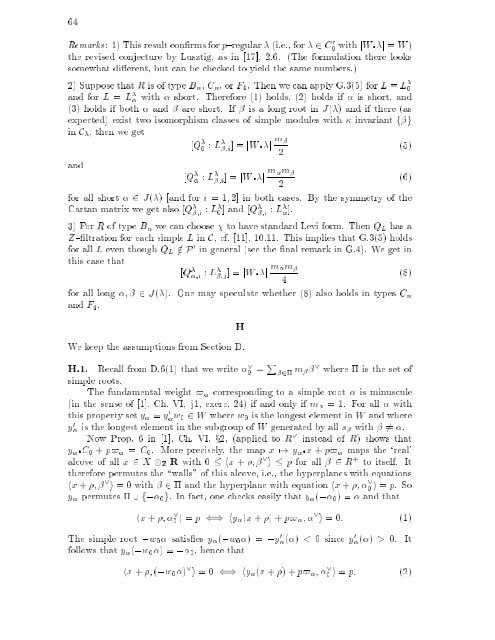subregular nilpotent representations of lie algebras in prime ...
subregular nilpotent representations of lie algebras in prime ...
subregular nilpotent representations of lie algebras in prime ...
You also want an ePaper? Increase the reach of your titles
YUMPU automatically turns print PDFs into web optimized ePapers that Google loves.
64<br />
Remarks: 1) This result con rms for p{regular (i.e., for 2 C 0 0 with jW j = W )<br />
the revised conjecture by Lusztig, as <strong>in</strong> [17], 2.6. (The formulation there looks<br />
somewhat di erent, but can be checked to yield the same numbers.)<br />
2) Suppose that R is <strong>of</strong> type Bn, Cn, orF4. Thenwecan apply G.3(5) for L = L0 and for L = L with short. Therefore (1) holds, (2) holds if is short, and<br />
(3) holds if both and are short. If is a long root <strong>in</strong> J( ) and if there (as<br />
expected) exist two isomorphism classes <strong>of</strong> simple modules with <strong>in</strong>variant f g<br />
<strong>in</strong> C ,thenweget [Q0 : L ;i] =jW j m<br />
2<br />
(5)<br />
and<br />
[Q : L ;i] =jW<br />
m m<br />
j<br />
2<br />
(6)<br />
for all short 2 J( ) [and for i =1; 2] <strong>in</strong> both cases. By the symmetry <strong>of</strong> the<br />
Cartan matrix we get also [Q ;i : L0] and [Q ;i : L ].<br />
3) For R <strong>of</strong> type Bn we can choose to have standard Levi form. Then QL has a<br />
Z{ ltration for each simple L <strong>in</strong> C, cf. [11], 10.11. This imp<strong>lie</strong>s that G.3(5) holds<br />
for all L even though QL =2 P 0 <strong>in</strong> general (see the nal remark <strong>in</strong> G.4). We get<strong>in</strong><br />
this case that<br />
[Q ;i : L ;j ]=jW j<br />
m m<br />
4<br />
for all long ; 2 J( ). One may speculate whether (8) also holds <strong>in</strong> types Cn<br />
and F4.<br />
We keep the assumptions from Section D.<br />
H<br />
H.1. Recall from D.6(1) that we write _ 0 = P 2 m _ where is the set <strong>of</strong><br />
simple roots.<br />
The fundamental weight $ correspond<strong>in</strong>g to a simple root is m<strong>in</strong>uscule<br />
(<strong>in</strong> the sense <strong>of</strong> [1], Ch. VI, x1, exerc. 24) if and only if m =1. For all with<br />
this property sety = y 0 w0 2 W where w0 is the longest element <strong>in</strong>W and where<br />
y 0 is the longest element <strong>in</strong> the subgroup <strong>of</strong> W generated by all s with 6= .<br />
Now Prop. 6 <strong>in</strong> [1], Ch. VI, x2, (app<strong>lie</strong>d to R _ <strong>in</strong>stead <strong>of</strong> R) shows that<br />
y C0 + p$ = C0. More precisely, the map x 7! y x + p$ maps the `real'<br />
alcove <strong>of</strong>allx 2 X Z R with 0 hx + ; _ i p for all 2 R + to itself. It<br />
therefore permutes the \walls" <strong>of</strong> this alcove, i.e., the hyperplanes with equations<br />
hx + ; _ i = 0 with 2 and the hyperplane with equation hx + ; _ 0 i = p. So<br />
y permutes [f, 0g. In fact, one checks easily that y (, 0) = and that<br />
hx + ; _<br />
0 i = p () hy (x + )+p$ ; _ i =0: (1)<br />
The simple root ,w0 satis es y (,w0 )=,y 0 ( ) < 0 s<strong>in</strong>ce y 0 ( ) > 0. It<br />
follows that y (,w0 )=, 0, hence that<br />
hx + ; (,w0 ) _ i =0 () hy (x + )+p$ ; _<br />
0 i = p: (2)<br />
(8)

















